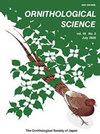台湾栎林与雪松混交林中绿背山雀的供给弹性与雏鸟生长
IF 0.3
4区 生物学
Q4 ORNITHOLOGY
引用次数: 0
摘要
摘要在异质景观中,鸟类可能会将繁殖尝试与当地食物丰富程度相比较。鸟类如何应对这一挑战的研究很少。在这项研究中,我们比较了绿背山雀在由本地混合橡树林和外来日本雪松柳杉人工林组成的景观马赛克中筑巢的供应行为和筑巢条件。在幼虫稀少的种植园中,母鸟的繁殖时间与在幼虫丰富的森林中一样,并且有相似大小的窝。我们发现,亲本鸟类在根据幼虫数量调整猎物选择标准方面是灵活的。早春,在幼虫丰度较低的雪松种植园中,雄性父母会像在混合橡树林中一样,不断地在附近给早期的幼崽喂食,但减少了它们对幼虫的饮食专门化,而雌性鸟类则增加了它们的供应频率。结合父母双方的努力,在雪松种植园饲养的早期幼崽比在混合橡树林中的幼崽更频繁地获得食物,非幼虫猎物的比例也更高。相比之下,在后期育婴期间,当幼虫数量充足时,种植园中的父母双方都以牺牲其他猎物为代价,大量捕食幼虫,就像他们在混合橡树林中所做的那样。我们发现,随着大型幼虫对饮食的贡献增加,亲鸟饲养的雏鸟体重更重。此外,在种植园早期孵化期间,幼鸟的体重低于混合橡树林中的幼鸟。我们建议,当绿背山雀的繁殖尝试与栖息地的幼虫食物供应不太同步时,它们的供应灵活性有助于收集食物来饲养雏鸟。因此,它们可以在异国情调的雪松种植园中成功繁殖。本文章由计算机程序翻译,如有差异,请以英文原文为准。
Provisioning Flexibility and Nestling Growth of Green-Backed Tit Parus monticolus in a Mosaic of Mixed-Oak Forest and Cedar Plantation in Taiwan
Abstract In heterogeneous landscapes, birds may mistime their breeding attempts relative to local food abundance. How birds cope with this challenge has been little studied. In this study, we compared the provisioning behavior and nestling condition of the Green-backed Tit Parus monticolus nesting in a landscape mosaic comprised of native mixed-oak forests and exotic Japanese Cedar Cryptomeria japonica plantations. Parent birds in the larvae-poor plantations time their breeding as they do in the larvae-rich forests and have clutches of similar size. We found that parent birds were flexible in adjusting their criteria for prey choice on the basis of larval abundance. In early spring, in cedar plantations where larval abundance was low, male parents maintained constant nearby feeding trips to the early broods, just as they did in the mixed-oak forests, but reduced their dietary specialization on larvae, while female birds increased their provisioning frequency. Combining both parents' efforts, the early brood nestlings raised in the cedar plantations received food deliveries more frequently and with a higher proportion of non-larval prey than their counterparts did in the mixed-oak forests. In contrast, during late brood rearing, when larvae were abundant, both parents in the plantations foraged heavily on larvae at the expense of other prey, just as they did in the mixed-oak forests. We found that parent birds reared heavier nestlings as the contribution of large larvae to the diet increased. Moreover, the nestlings during early broods in the plantations had lower body weights than their counterparts in the mixed-oak forests. We suggest that the provisioning flexibility of Green-backed Tits helps them gather food for raising nestlings when their breeding attempts are less synchronized with the larval food supply in their habitat. As a result, they can breed successfully in the exotic cedar plantations.
求助全文
通过发布文献求助,成功后即可免费获取论文全文。
去求助
来源期刊

Ornithological Science
ORNITHOLOGY-
CiteScore
1.20
自引率
0.00%
发文量
26
审稿时长
>12 weeks
期刊介绍:
Ornithological Science publishes reviews, original articles, short communications and comments covering all aspects of ornithology. Manuscripts are judged on the basis of their contribution of original data and ideas or interpretation. All articles are peer-reviewed by at least two researchers expert in the field of the submitted paper. Manuscript are edited where necessary for clarify and economy. Ornithological Science aims to publish as rapidly as is consistent with the requirements of peer-review and normal publishing constraints.
 求助内容:
求助内容: 应助结果提醒方式:
应助结果提醒方式:


